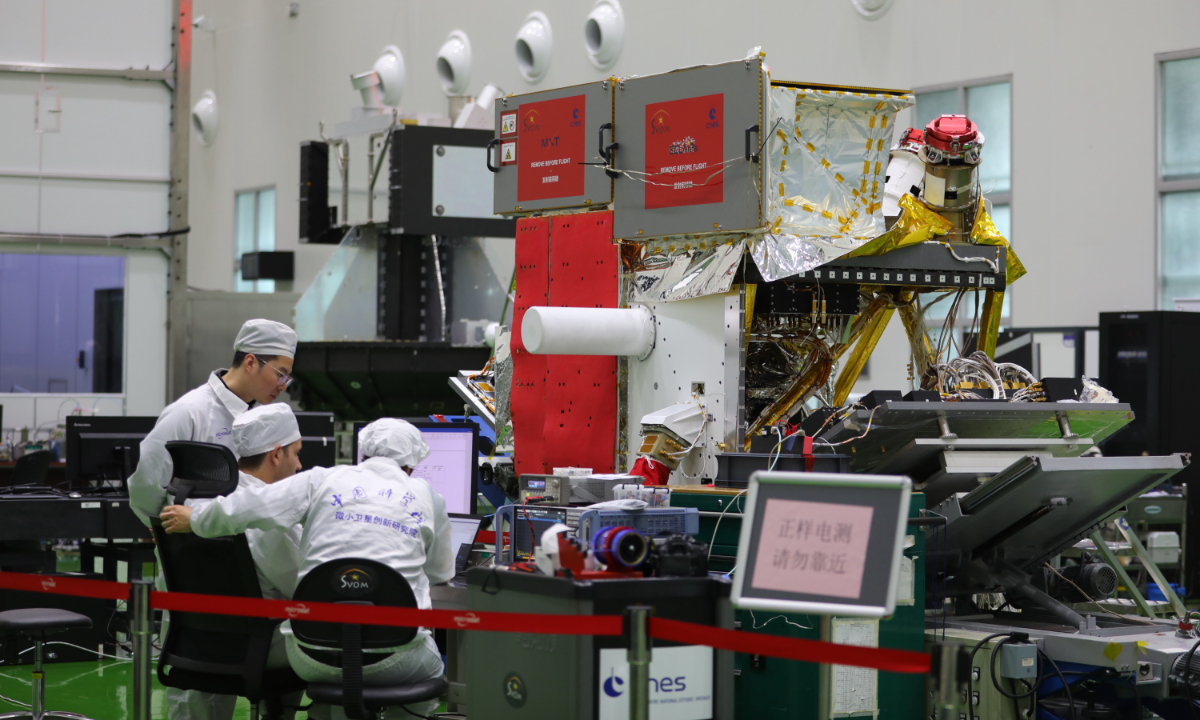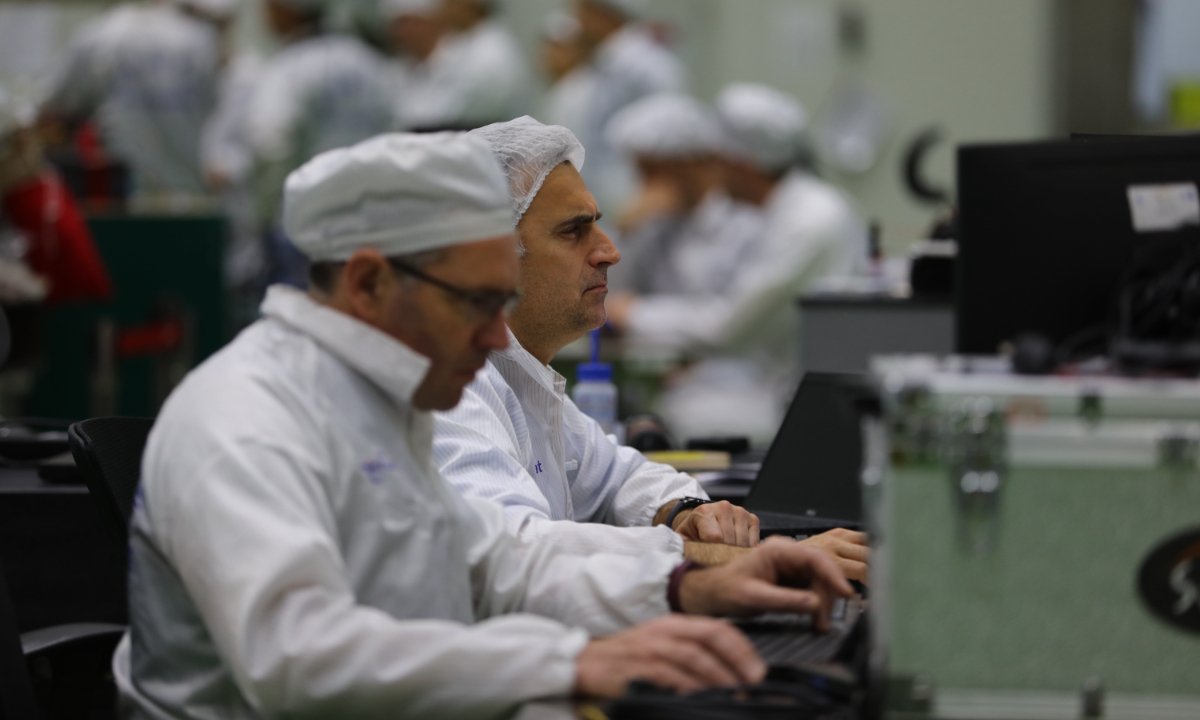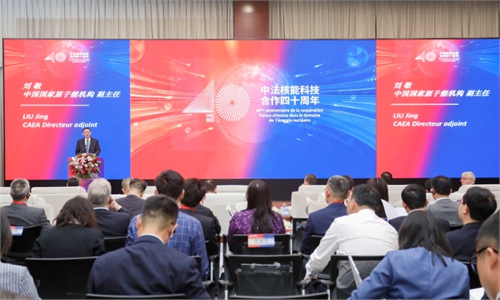Exclusive: China, France to forge stronger space cooperation with new satellite program to hunt for gamma-ray bursts

The SVOM satellite is in the assembling and testing process at Innovation Academy for Microsatellites of Chinese Academy of Sciences on May 17, 2023. Photo: Chen Xia/GT
As the second satellite-related cooperation between China and France, the Space-based multi-band astronomical Variable Objects Monitor (SVOM) which is jointly developed by the China National Space Administration (CNSA) and the Centre National d'Etudes Spatiales (CNES), France's space agency, has come to the final assembly, integration and test (AIT) stage in Shanghai. It is expected to launch into space in 2024 Spring. Global Times has learned from Chinese and French engineers working on the cooperative frontline.
"We have integrated the final equipment onto the satellite platform, with functional testing being under way. According to the current plan, the SVOM will be launched via China's Long March-2C carrier rocket from Xichang Satellite Launch Center in 2024 Spring," Zhang Xiaofeng, assistant chief designer of the SVOM satellite, updated during an exclusive interview with the Global Time at the Innovation Academy for Microsatellites of Chinese Academy of Sciences (IAMC) or known as the Microsat, where the satellite is assembled and tested.
The SVOM project is a collaboration forged in 2014 and the second satellite-related cooperation between China and France, following the China-France Oceanography Satellite (CFOSat) that was launched into orbit in 2018 and became operational ever since.
The SVOM is designed to hunt short-lived and extremely violent cosmic explosions known as gamma-ray bursts (GRB) by detecting high-energy electromagnetic radiation in the X-ray and gamma-ray ranges.
To achieve that, Chinese scientists and engineers have developed a pair of instruments for the satellite. They are the Gamma-Ray Monitor (GRM) to measure the spectrum of emissions from GRBs and Visible Telescope (VT) which will look for light emitted in optical wavelengths immediately after a gamma-ray burst event.
Meanwhile, the French side provided ECLAIRs telescope and Microchannel X-ray Telescope (MXT), onboard the SVOM.
The satellite platform where the parts are assembled onto was also developed by the Chinese side. And the platform will provide high stability as well as autonomouscontrol for the satellite during its hunting for weak signals in the universe.
With China and France each providing two instruments, the SVOM will be able to carry out observation of GRBs, simultaneously and with a vast wavelength range from soft X ray to the high energy Gamma ray and visible light, Zhang explained.
The satellite is also empowered by China's BeiDou Navigation Satellite System (BDS), being able to use the BDS short message services as well as the French VHF network, so that the SVOM could transmit an alert signal back to the ground station within five minutes after it detects a GRB event, to notify ground-based large-aperture telescopes around the world as well as other GRB satellite such as the SWIFT to observe such event altogether.

Two French engineers observe the testing data of SVOM satellite at Innovation Academy for Microsatellites of Chinese Academy of Sciences on May 17, 2023. Photo: Chen Xia/GT
Agree to disagree
"The French and the Chinese team work for more than 10 years together, from the design phase to the preparation, the development and until the integration of the French instrument on the Chinese platform," Sanisidro Julien, French Payload MXT AIT manager, told the Global Times.
"We have a very good relationship between the Chinese engineer and the French engineer," Julien said.
And when asked if it was difficult for the French team to communicate with their Chinese counterparts, Julien said that "No, it's not difficult. We did a lot of meeting before we started and during the development of the project. And we have a strong relationship. We have a good communication. It's not complicated. It's just a little bit different, but it's good for the experience."
We did have many discussions at the early designing stage. And it has been a long journey with lots of disagreements and compromises, but both sides were always sharing the same objective of high quality and making it on schedule, Chen Kun,Satellite engineer of SVOM satellite, who is also in charge of communicating with the French team, told the Global Times.
We had different ideas on how to allocate the satellite resources, different standards, too - one is the European standard and the other one is Chinese one. Gladly, we reached agreements in the end, Chen said.
Citing the recent AIT stage for example, more than 10 French engineers came to Shanghai to deliver the instruments and integrate them on the satellite platform for testing. We have about the same number of engineers working here too. We would have discussions all along the way, Chen recalled.
The working habit was also different, Chen said. " The French colleagues were relatively slower in tempo but they were very careful and thoughtful on details. We have a big screen here in the workplace, so that we can coordinate and confirm with each other to ensure every step is leading to the right direction without errors." Chen recalled.
We had frequent communication such as weekly online meetings especially during the three years of COVID-19 pandemic, through which we have built strong connection and figured out how to communicate with each other, Chen said.
Future prospects
The SVOM Chinese team told the Global Times that they were looking forward to more cooperation with their French colleagues in the future.
France has rich experience in space astronomy, ocean as well as atmosphere monitoring. We are hoping to deepen our cooperation with them in those fields and even in exploration of planets outside the solar system, they said.
The future of China-France cooperation in space has only more reasons to expect with the closer bond and experience from two satellite-based projects - CFOSat and SVOM.
The two nations have also said in a joint declaration that they welcome the cooperation between their space institutions regarding the Chang'e 6 probe and joint studies of extraterrestrial samples. The document was released by the two nations during French President Emmanuel Macron's recent visit to China in April.
As a crucial part of the International Lunar Research Station basic version construction stage, China will launch the Chang'e-6 moon probe by around 2024, which will be first-ever lunar sample returning mission from the dark side of the satellite for mankind.
The Chang'e 6 mission will enable French scientists to place their equipment on the silver celestial body's little-known far side, according to China's leading space contractor China Aerospace Science and Technology Corp.



